

Finding a location for two of the four University of Iowa XPOL radars was easy. They will remain at their current home base locations near Iowa City and Cedar Rapids overlooking the Clear Creek Watershed for the IFloodS campaign. For the other two destined for the Turkey River basin in northeast Iowa — well, there was work to be done.
As is typical, finding the “ideal” radar locations proved to be challenging. The primary goal was simple enough — a high spot with a good view. Then we add in the need for power, communications, and access, and it becomes more complicated.
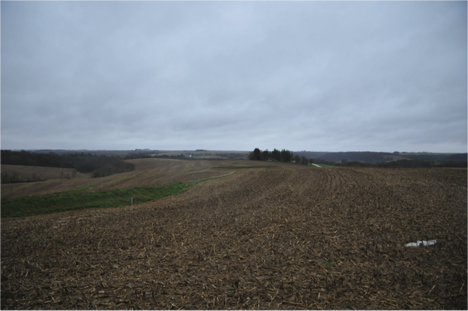
The Turkey River basin, unaltered by glaciers, is rugged and hilly by Iowa standards. Lots of great views, but the ruggedness that makes some of the land difficult to farm, and also means there are a lot of obstructions on the tops of hills, namely tall trees. This image is the “radar’s eye “ view from the St. Olaf site and demonstrates why it was chosen. Credit: Iowa Flood Center
After much planning, looking at satellite images, talking with local cities and groups, it was time to visit the basin for a reality check. Many sites that had appeared so promising became distant memories, but new possibilities arose with help of local individuals from the City of Decorah, the City of Calmar, local IDNR staff, Northeast Iowa Community College, and others. We are grateful for their “touring the countryside” time and cooperation. In the end, two very attractive locations were secured, one in Calmar and one south of St. Olaf.
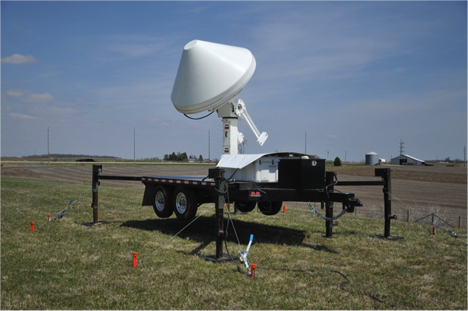
April 30, 2013, Calmar site: The XPOL installation at Calmar went smoothly enough. It was very windy, but sunny, with mild temperatures. For the follow-up installation of the communications, we dealt with very windy conditions and ice-covered surfaces. Credit: Iowa Flood Center
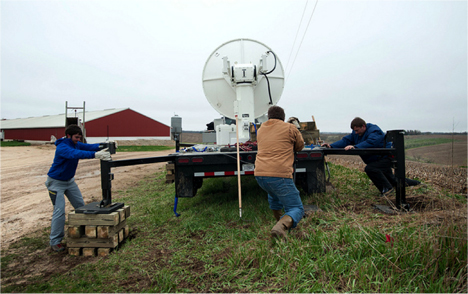
May 2, 201, St. Olaf Site: The St. Olaf installation was a bit better, 38 degrees F (warm??) , overcast, and very windy, with rain all day. Visiting scholar Jacopo Grazioli, Dan Ceynar, and Radek Goska of the Iowa Flood Center adjust the radar position on the cribbing. Credit: Iowa Flood Center
As many visiting researchers and NASA and scientist are now fully aware, the weather in Iowa is constantly changing, often between extremes. The weather during the installation of the XPOL radars was challenging, ranging mostly from cold, windy, and rainy to windy and icy. Very challenging indeed. Tenacity prevailed, and both new radar locations were successfully installed at the beginning of the month despite the adverse weather conditions.
From May 1 to June 15, NASA and Iowa Flood Center scientists from the University of Iowa will measure rainfall in eastern Iowa with ground instruments and satellites as part of a field campaign called Iowa Flood Studies (IFloodS). They will evaluate the accuracy of flood forecasting models and precipitation measurements from space with data they collect.
Dan Ceynar is a staff engineer at the Iowa Flood Center. He coordinates many of the Iowa Flood Center’s instrumentation networks across Iowa including stream sensors, rain gauges, and XPOL radars. This spring, he has been busy working with NASA and IFC staff to deploy instruments for the IFloodS campaign.
Last year, when working with the NASA GPM team in the planning stages for the Iowa Flood Studies project, more affectionately known as IFloodS, I worried — a lot.
2012 was a year of historic drought in Iowa. IFloodS is all about studying and measuring precipitation. What if drought continued into 2013? In short, what if it didn’t rain?
Turns out my fears were unfounded. The spring of 2013 has turned out to be wet. Very wet. In mid-April, Iowa City got 4.5 inches in a single day, while nearby North Liberty’s rainfall totaled a whopping 8.3 inches that has less than 1% chance of being exceeded in any given year.
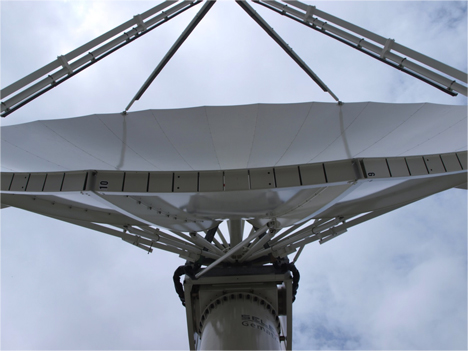
May, 2013. Despite a drought in 2012, the NASA NPOL radar near Waterloo has been able to capture information from multiple precipitation events in Iowa this spring. Credit: Witold Krajewski / Iowa Flood Center
OK, so I am no longer worrying that we’ll set up some of the most sophisticated instrumentation in the world for measuring precipitation, only to find ourselves measuring dust.
This last weekend I got the chance to drive around the state and see firsthand what heavy rainfall was doing to Iowa’s streams, rivers, and landscape. I drove north out of Iowa City to the NASA NPOL radar site near Waterloo. As I crossed many streams and rivers in the Cedar River basin, I observed water running high and fast.
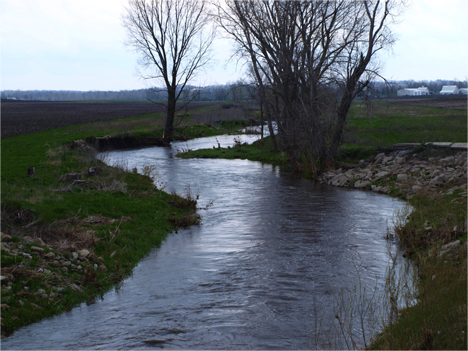
May, 2013. Many Iowa streams are bank full this spring after heavy April rain events. Credit Witold Krajewski / Iowa Flood Center
Later on, I drove south to pick up my wife from a horseback outing, and I saw more elevated stream levels and saturated farmland. Many streams were overflowing the banks. It reminds me that everything we do at the Iowa Flood Center cannot completely prevent floods and the damage they bring. We can better inform people about impending floods, and we can improve mitigation strategies to lessen the damage. These are all worthwhile activities that I believe in wholeheartedly. But it’s worth remembering, even as we are in the midst of this exciting project, that it’s not the state-of-the-art technology or the groundbreaking studies that matter the most — it’s the people we serve, the citizens of Iowa and citizens of the world, who are living with floods.
Witold Krajewski is the director of the Iowa Flood Center, based at the University of Iowa in Iowa City. He is a professor in the Department of Civil and Environmental Engineering and serves as the Rose & Joseph Summers Chair of Water Resources Engineering. His scientific interests concern measuring, modeling, and forecasting precipitation using radar and satellite remote sensing.
The big science highlight so far is that over May 2 through May 4, the GPM Ground Validation team finally collected a coordinated, co-scanned multi-radar frequency and dual-polarimetric dataset with the D3R and NPOL radars and we did it in one of the most complex multi-day precipitation events that we’ll measure in mid and high latitudes – a mixture of rain, snow and sleet.
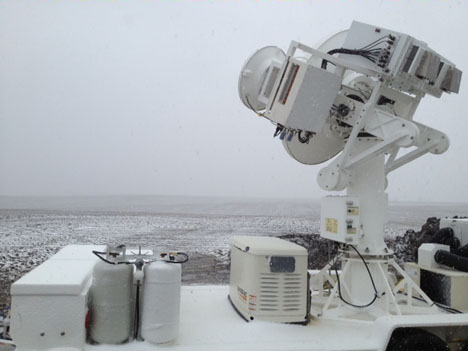
May 3, 2013. The D3R radar, which measures precipitation at similar frequencies as the radar on the GPM Core satellite, measured rain, snow, and sleet at the Traer site in Iowa. Credit: Walt Petersen / NASA
In fact, the snowfall portion of the storm turned out to be a record event for Iowa in May. The fact that D3R and NPOL co-scanned the event is important because you have a longer wavelength, high power reference radar (NPOL) with dual-polarization (both vertical and horizontal scans), and hence enhanced capability to discern specifics on precipitation shapes, sizes and numbers, scanning coincident with a radar (D3R) that carries the same higher frequencies that the DPR radar will carry on the GPM Core Satellite.
The higher frequencies of the D3R are more sensitive, but will often attenuate, or dissipate, faster in the mixture of precipitation we sampled. So, you can test how well you can correct for that attenuation and retrieve the complex precipitation structure from the D3R, which is our proxy for the space-borne radar, against your reference platform, the NPOL. At the same time, we learn a great deal about the precipitation physics when we look at things with 3 different frequencies and in dual-polarization modes.
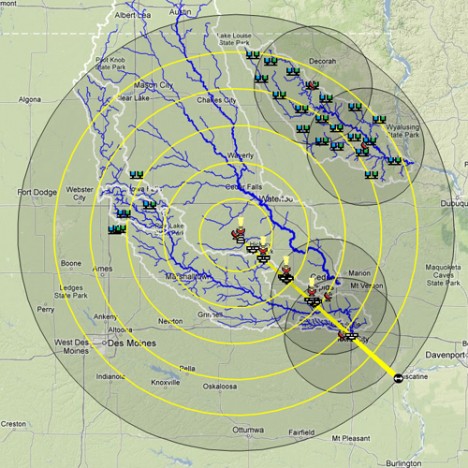
Map of field locations of IFloodS instruments. The NPOL and D3R radars are located dead center and a ray of disdrometers and rain gauges stretches southeast toward Iowa City in the bottom right. Other rain sensors are distributed throughout the Turkey River basin in the north east and the south fork of the Iowa river west of Traer. Credit: Iowa Flood Center
Moreover, we did this over a “reference” 100 km-long ray of disdrometers, vertically pointing micro rain radars, and rain gauges – all in all, what will probably amount to a great deal of information to interpret.
From May 1 to June 15, NASA and Iowa Flood Center scientists from the University of Iowa will measure rainfall in eastern Iowa with ground instruments and satellites as part of a field campaign called Iowa Flood Studies (IFloodS). They will evaluate the accuracy of flood forecasting models and precipitation measurements from space with data they collect. Walt Petersen, a scientist based at NASA’s Wallops Flight Facility, is the Ground Validation Scientist for the Global Precipitation Measurement (GPM) mission.
Our forecasters at Iowa State, and I believe via the National Weather Service, are calling this a “once in a career storm.” The heavy snow in central Iowa—really, almost on top of us right now, is the reason. We ran NPOL all night long with the D3R radar in cold rain that started around 2 a.m. I awoke to some ice pellets this morning around 5 a.m. in my hotel room and then wind-driven rain. The wind has been blowing a steady 25 to 30 mph.
We had some funny things happen with the antenna last night. Wind stopped it a few times in big gusts; it is a big 28-foot “sail” after all, and then we had some miscommunication between the antenna controller and the software that controls scanning. The radar scientist on duty, Dr. Timothy Lang, came up with a good work-around. His solution was to run constant “PPI volumes,” which basically do a full 360 degree sweep at several elevation angles. This enabled us to keep collecting good data and to do it at our sub-3 minute cycle time. We set that time as the outside limit on how frequently we wanted to fully sample the rainfall field around us.
We got the antenna situation repaired this morning, and I was able to go back into alternate rain scan vs. range-height scanning mode with the D3R, so that we sample both the rain field and the structure of the precipitation with height at very high resolution along our ray of disdrometers and rain gauges that stretch in a line toward Iowa City.
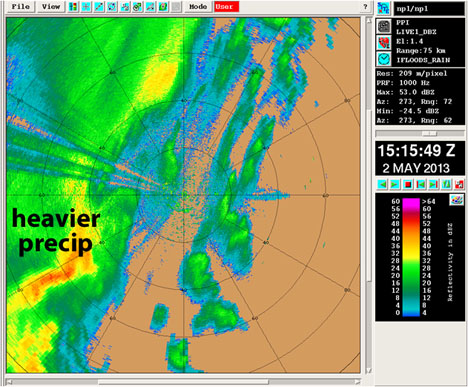
May 2, 2013. A radar image similar to what you’d see in a weather report. Precipitation appears in colors ranging from light rain (blue to green) to heavier precipitation (yellow to red). Credit: NPOL radar / NASA
One thing that is really impressive is the change in precipitation type, and the rapid drop in the height of the freezing level we are seeing as one moves west of the radar. This is illustrated nicely in the dual-polarimetric data that the radar collects. The first image (above) shows an example of the radar reflectivity field that we saw around 15:15 UTC (or 10:15 local time). This variable is typically what your TV Meteorologist shows you on the evening newscast. Notice the band of higher reflectivity just to the west of the radar that indicates heavier rain.
Now the second image (below) shows a variable called the “correlation coefficient” or, RHOHV. This variable takes the signal at both the horizontal and vertical polarizations and computes their correlation at each range sample along all the rays. It is a sensitive measure of the degree to which you have a mixture of liquid and frozen precipitation particles in a given sample volume.
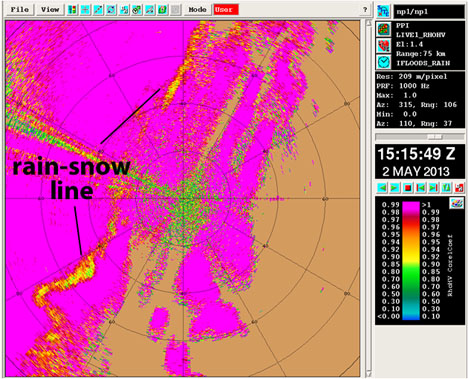
May 2, 2013. This radar image combines two measurements to show what the mixture of liquid and ice is in the precipitation. Bright pink is liquid rain. Yellow to red shows that snow and ice are mixed with the rain. The line of this rain-snow mix stretches from the southwest (bottom left) to the northeast (top right) of the NPOL radar. Credit: NPOL radar / NASA
Raindrops are usually very highly correlated and values will typically exceed 0.98 or so. However, when you get a mixture of snow and rain, the correlation drops rapidly. You can see this rapid drop in correlation to the west of the radar along the narrow line yellowish to orange colors (embedded in the solid pinkish colors of high RHOHV) that extend in a line from southwest of the radar up to the northeast of the radar. That is where the infamous rain-snow line is located in Central Iowa. We await the arrival of that line over NPOL—though it is only progressing eastward very slowly.
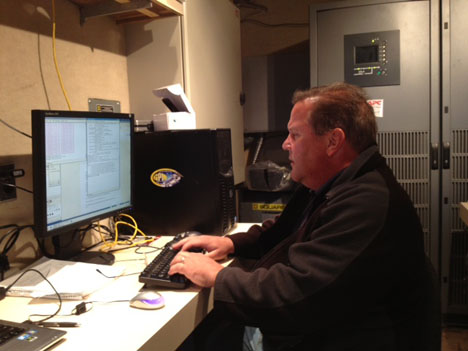
Dave Wolff is a radar scientist at NASA Wallops. He is monitoring the radar data inside the science trailer on site at Traer, Iowa. Credit: Walt Petersen / NASA
Dave Wolff (above), my companion Radar Scientist this week, and also from NASA Wallops, has done a great job of getting some of our NPOL imagery online in real time, so that is a big help to the field operations. It seems that most of the equipment and networking is working- a testament to the hard work several of these folks are putting in.
I must say though, right now I am most anxiously awaiting a hot cup of coffee which one of our Radar Engineers has graciously offered to grab for me on his lunch run.
From May 1 to June 15, NASA and Iowa Flood Center scientists from the University of Iowa will measure rainfall in eastern Iowa with ground instruments and satellites as part of a field campaign called Iowa Flood Studies (IFloodS). They will evaluate the accuracy of flood forecasting models and precipitation measurements from space with data they collect. Walt Petersen, a scientist based at NASA’s Wallops Flight Facility, is the Ground Validation Scientist for the Global Precipitation Measurement (GPM) mission.
We have been waiting for rain at the NPOL site. Yesterday evening it got very close- within 50 km or so. In the interim, we were waiting for convective cells to develop along what is called a radar “fine-line”. Fine-lines are little boundaries in the lowest part of the atmosphere associated with small changes in wind, temperature and/or humidity that often work to focus bugs. They are very visible to the radar and are often (though not always) associated with a line of cumuliform clouds which will sit over the top of the boundary. The clouds form in response to convergence and mixture of the moisture along the fine line and tend to “ride” it as it propagates along. Often, deeper more vigorous rain cells will develop along these lines as they intersect other cloud rolls or boundaries.
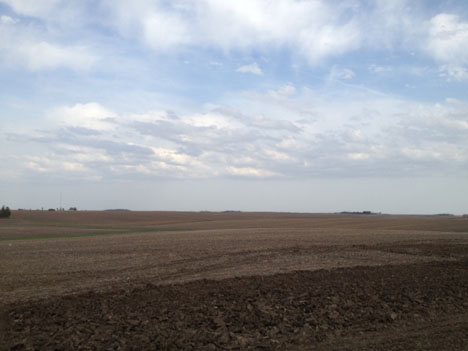
May 1, 2013. Clouds along the “fine-line”, a boundary that means a change in wind, temperature and/or humidity is occurring. Credit: Walt Petersen / NASA
At any rate, we watched one of these boundaries for quite some time yesterday with the radar. It passed NPOL in the afternoon (below) and I went out to take a quick picture of the clouds along it (above; which were unimpressive…..alas). However, southwest of Des Moines there were a few severe storms that developed along the same line; just didn’t happen in our area.
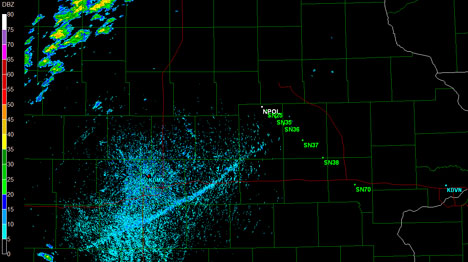
NPOL radar view of the “fine-line.” Clouds and rain are shown in blue. The NPOL position is labeled in white and the line of green sites show where the ground instruments are located. Credit: NASA
Today (currently) we are awaiting a major storm system that is sitting just to our west and northwest and producing rain mixed with snow in the northwest corner of Iowa — the same system that was producing snow in Colorado early this morning. It looks to be wet and cold here for the next few days after the storm arrives. If and when we get the rain/snow mix, we will focus very hard on coordinated scanning with the D3R as this will be a very unique opportunity for us to collect data in a mixed-phase event with three different radar frequencies at dual-polarization. Since this situation happens more often in the mid-latitudes, and GPM will extend our rain and snowfall measurement capability into the mid-latitudes, this could be a great case for looking at the famous “rain-snow line” transition and how our GPM radar and radiometer algorithms will work in this situation.
From May 1 to June 15, NASA and Iowa Flood Center scientists from the University of Iowa will measure rainfall in eastern Iowa with ground instruments and satellites as part of a field campaign called Iowa Flood Studies (IFloodS). They will evaluate the accuracy of flood forecasting models and precipitation measurements from space with data they collect. Walt Petersen, a scientist based at NASA’s Wallops Flight Facility, is the Ground Validation Scientist for the Global Precipitation Measurement (GPM) mission.